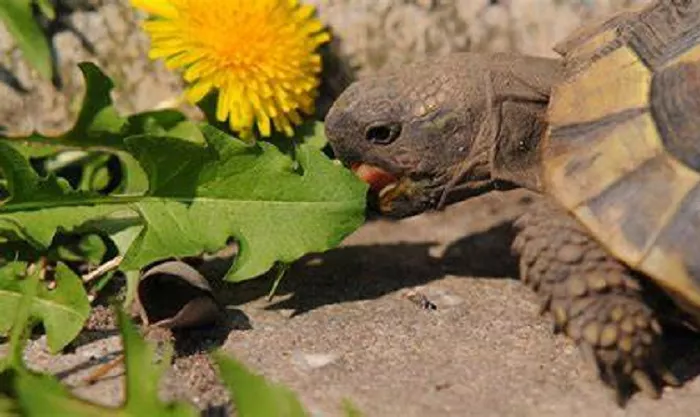Hermann tortoises are delightful pets that require a well-balanced diet to thrive. Providing them with a variety of safe and nutritious plants is essential for their health and well-being. This article explores the best plants that Hermann tortoises can eat, ensuring they receive the necessary nutrients while enjoying a natural and enriching environment.
Introduction
Hermann tortoises thrive on a varied diet of safe and nutritious plants. This article provides a comprehensive guide to the best plants for your tortoise, ensuring a healthy and enriching environment.
Safe Plants for Hermann Tortoises
1. Dandelion (Taraxacum officinale)
Dandelions are a favorite among Hermann tortoises due to their high nutritional value. They are rich in calcium, vitamins A and C, and are safe to consume in large quantities. Both the leaves and flowers are edible, making them a versatile addition to your tortoise’s diet.
2. Clover (Trifolium spp.)
Clover is another excellent choice, providing a good source of protein and fiber. Both red and white clovers are safe for tortoises, though moderation is key due to their high protein content.
3. Plantain (Plantago spp.)
Plantain is a nutritious plant that offers a good source of fiber and minerals. Both broadleaf and narrowleaf varieties are safe and palatable for Hermann tortoises.
4. Hibiscus (Hibiscus rosa-sinensis)
Hibiscus flowers and leaves are high in vitamin C and antioxidants, making them a healthy and appealing option for tortoises. They add variety to the diet and are safe to consume.
5. Grape Vine Leaves (Vitis vinifera)
Grape vine leaves are rich in vitamins A, C, and K. They are safe and nutritious, though the fruit should be offered sparingly due to its sugar content.
6. Mulberry Leaves (Morus spp.)
Mulberry leaves are high in calcium and protein, making them a great addition to your tortoise’s diet. However, the fruits should be limited.
7. Nasturtium (Tropaeolum majus)
Nasturtiums are rich in vitamin C and have a peppery taste that tortoises enjoy. Both the leaves and flowers are edible and safe.
8. Tropical Hibiscus (Hibiscus rosa-sinensis)
This plant is a favorite among tortoises. Both the flowers and leaves are nutritious and appealing. They require more watering and protection from intense sun in hotter climates.
9. Aloe (Aloe species)
Aloe is safe in moderation. The gel can also be used topically on minor tortoise skin injuries. However, excessive consumption can have a mild laxative effect.
10. Jade Plant (Crassula argentea)
This hardy succulent can tolerate dry conditions. Feed in moderation, as overindulgence of any succulent may cause diarrhea.
11. Spineless Prickly Pear Cactus (Opuntia species)
This cactus is a fantastic source of hydration and nutrients. Ensure there are no spines present, as these can cause injury.
12. Yucca (Yucca species)
Yucca provides cover and can be nibbled on. It is a resilient option for a tortoise enclosure.
13. Dark Leafy Greens
Healthy greens such as Romaine lettuce, kale, collard, mustard, and dandelion greens are excellent choices for your tortoise’s diet.
14. Echeveria
This succulent is safe for tortoises to consume in moderation. Overindulgence can result in diarrhea.
15. Marigold (Calendula species)
Marigold flowers and leaves are safe and often enjoyed by tortoises as part of a varied diet. Be careful not to use Tagetes marigold, which isn’t good for tortoises.
16. Basil
Basil can be fed in moderation. However, your tortoise might not find it appetizing because of the strong aroma and taste.
17. Cucumber
Cucumber can be offered to help with hydration, or prescribed medication can be hidden within it and offered to the tortoise as a tasty treat. The leaves and flowers of the cucumber plant may be fed in small amounts to all species.
18. Spider Plant (Chlorophytum comosum)
Spider plants are non-toxic and resilient, making them ideal for providing ground cover and aesthetic appeal in a tortoise enclosure.
19. Hens and Chicks (Sempervivum spp.)
These hardy and drought-resistant plants are non-toxic and can provide a safe, attractive ground cover.
20. Pothos (Epipremnum aureum)
Pothos is easy to grow and maintain. It is non-toxic and provides climbing opportunities for enrichment.
21. Boston Fern (Nephrolepis exaltata)
Boston ferns add humidity and aesthetic appeal. They are non-toxic and safe, though not a food source.
Plants to Avoid
Certain plants can be toxic or harmful to Hermann tortoises. Avoid azaleas, daffodils, foxglove, and nightshade plants such as tomatoes and potatoes, as they contain compounds that can cause severe health issues. Even some common houseplants, like pothos and philodendrons, pose risks if ingested.
Tips for Integrating Live Plants
Quarantine New Plants
Before introducing new plants, quarantine them for a few weeks to ensure they are free from pesticides and pests.
Gradual Introduction
Introduce new plants gradually to monitor the tortoise’s reaction. This helps prevent digestive issues and ensures a safe diet.
Diverse Diet
Ensure a variety of plants to provide a balanced diet and prevent over-reliance on a single food source.
Monitor Plant Health
Regularly check the health of the plants and replace any that become damaged or unhealthy.
Conclusion
Providing a variety of safe and nutritious plants is essential for the health and well-being of Hermann tortoises. By carefully selecting and maintaining these plants, you can create a vibrant and enriching environment for your shelled companion. This enhances their physical well-being and provides mental stimulation, leading to a happier, healthier pet.


